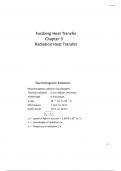Presentation
Chapter 9 Radiation Heat Transfer
- Course
- Institution
This chapter delves into radiation heat transfer, exploring electromagnetic wave-based heat exchange. It covers fundamental laws like Stefan-Boltzmann, Planck, and Wien's Displacement Laws. The importance of emissivity, absorptivity, and Kirchhoff's Law is highlighted. Practical applications in com...
[Show more]



